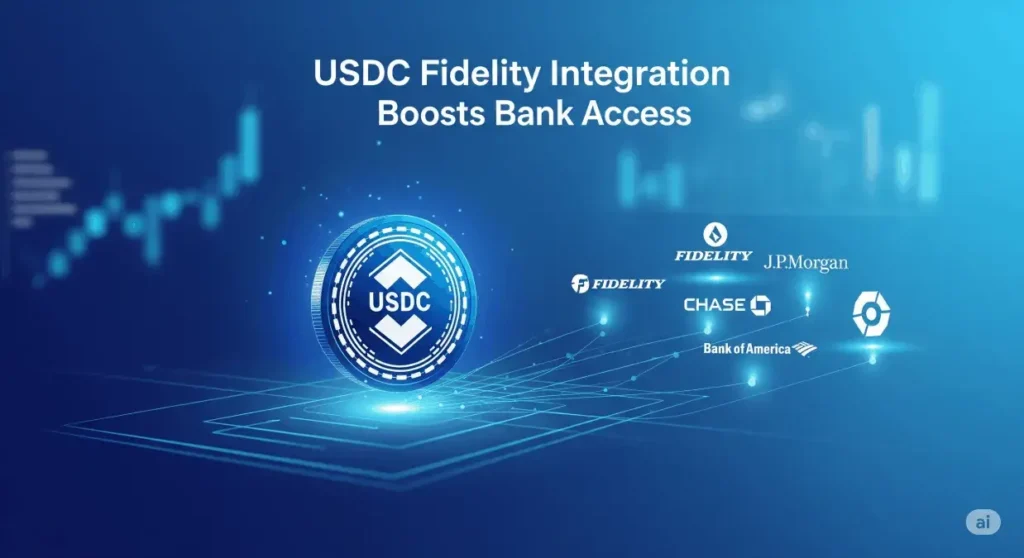USDC Fidelity Integration Opens New Era for Banks

In a landmark development for the world of digital finance, Circle’s USDC stablecoin is now poised to revolutionize traditional banking by becoming available to thousands of US banks through a strategic partnership with Fidelity National Information Services (FIS). This pivotal collaboration signifies a new chapter for the adoption of stablecoins within mainstream finance, dramatically expanding USDC’s utility in both domestic and cross-border payment ecosystems.
The integration of USDC into FIS’s extensive money movement hub is a clear reflection of the escalating demand for stable, blockchain-based payment solutions among traditional financial institutions. These institutions are increasingly seeking to modernize their services, enhance efficiency, and reduce costs in an ever-evolving global financial landscape. This USDC Fidelity Integration marks a significant leap forward, bridging the gap between innovative blockchain technology and established banking infrastructure.
A New Frontier for Stablecoins in Mainstream Finance
Circle’s collaboration with Fidelity National Information Services Inc. is not just another partnership; it represents a bold statement about the increasing relevance and trustworthiness of stablecoins in the broader financial sector. By embedding USDC directly into FIS’s vast money movement network, the two companies are jointly aiming to provide banks with a reliable, digital dollar option that can streamline payments across international borders and within the United States. This move is particularly impactful given USDC’s strong foundation: it is fully backed by a reserve of cash and short-term US Treasuries, a structure that underscores its transparency and regulatory alignment, positioning it ideally for even broader adoption.
FIS, a financial technology giant that processes over $10 trillion in transactions annually, views stablecoins not as a speculative or experimental asset, but as a practical and indispensable tool for modernizing financial operations. Himal Makwana, FIS’s global head of corporate strategy, underscored this perspective, emphasizing that digital dollar tokens like USDC have matured sufficiently to address tangible client needs across various critical dimensions. These include a heightened demand for speed in transactions, improved cost efficiency, and unwavering reliability in payment processing. The anticipation builds as this critical USDC Fidelity Integration is expected to go live before the end of the year, promising banks streamlined access to USDC’s robust payment rails through a single, convenient connection point. This simplifies what was once a complex process, encouraging wider adoption.
Stablecoin Payments Gaining Traction in Traditional Banking
The significance of this partnership was further highlighted by Circle’s chief business officer, Kash Razzaghi. He pointed out that aligning with a major banking technology provider like FIS lends immense credibility and provides unparalleled scale to USDC. Many US banks already rely on FIS’s robust infrastructure to connect seamlessly with multiple payment networks, a testament to FIS’s established reputation and reach. The addition of USDC to this already comprehensive toolkit offers a compelling alternative to legacy payment systems, which can often be characterized by their slowness and high costs, particularly when it comes to intricate cross-border transfers. The USDC Fidelity Integration directly addresses these pain points.
This pivotal step in stablecoin adoption coincides with a broader movement towards greater regulatory clarity for stablecoins within the United States. The ongoing progress in regulatory frameworks is actively encouraging traditional financial institutions to explore and integrate digital assets with enhanced safeguards, mitigating previous concerns about compliance and security. The competitive landscape within the financial technology sector also reflects this accelerating trend. Fiserv, a prominent rival to FIS, recently announced its own stablecoin, FIUSD, and is also collaborating with Circle. This parallel development further signals a widespread acknowledgment among established payment firms that embracing blockchain technology is not merely an option, but a strategic imperative to maintain competitiveness and relevance in the rapidly evolving digital economy.
Expanding Reach and Modernizing Financial Services
The broader implications of this USDC Fidelity Integration are far-reaching, promising to benefit both retail customers and businesses. For individuals and enterprises engaged in international money transfers, this partnership could usher in an era of faster settlements and significantly lower fees. For Circle, the ability to tap into FIS’s extensive network of thousands of bank clients represents a dramatic expansion of its reach, bypassing the cumbersome and time-consuming process of establishing direct connections with each bank individually. This strategic alliance is a testament to the power of indirect scaling and collaborative innovation.
Stay informed, read the latest crypto news in real time!
Blending Innovation with Existing Infrastructure
As trust in digital dollars continues to grow and new regulatory frameworks are actively debated in Congress, this integration serves as a compelling example of how stablecoins can seamlessly blend with existing banking systems, rather than attempting to outright replace them. This collaborative approach fosters an environment of evolution, allowing financial institutions to leverage the benefits of blockchain technology without disrupting their foundational operations. As payments become increasingly digital and inherently borderless, the next phase of USDC’s growth appears poised to build upon partnerships such as this USDC Fidelity Integration. Such alliances will be crucial in cementing USDC’s role as a fundamental component of everyday finance, driving efficiency and innovation across the global financial landscape. This development is not just about a new product offering; it’s about shaping the future of money movement.





2 thoughts on “USDC Fidelity Integration Opens New Era for Banks”